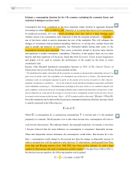Slidey : d = 0.3t(t-3.4)(t-9)
= 0.3(2)(2-3.4)(2-9)
= 0.3(19.6)
= 5.88(m)
(A distance of each snail when the time is 2min.)
- 5 minutes
Slippery : d = 4.4 + 0.55t
= 4.4 + 0.55(5)
= 4.4 + 2.75
= 7.15(m)
Slimy : d = 0.3t(t-7)
= 0.3(5)(5-7)
= 0.3(-10)
= -3(m)
Slidey : d = 0.3t(t-3.4)(t-9)
= 0.3(5)(5-3.4)(5-9)
= 0.3(-32)
= -9.6(m)(This means Slidey is going backward)
(A distance of each snail when the time is 5min.)
State which snail is leading the race at each time
∴ According to the results above
@ Slippery is leading the race at 0 min.
@ Slidey is leading the race at 2 min.
@ Slippery _ is leading the race at 5 min.
Secondly, we can use a graphics calculator. If we use a graphics calculator we would know not only the distance of each snail at each time but also which snail is leading the race at each time very simply and easily by comparing 3 points on the graph.
<Slippery> <Slimy> <Slidey>
@(Slippery is leading the race at 0 min.)
<Slippery> <Slimy> <Slidey>
@(Slidey is leading the race at 2 min.)
<Slippery> <Slimy> <Slidey>
@(Slippery is leading the race at 5 min.)
Conclusion:
As you can see graphs above
@ Slippery is leading the race at 0 min.
@ Slidey is leading the race at 2 min.
@ Slippery is leading the race at 5 min.
- With the aid of your graphical calculator, sketch the path of each snail include each graph in your report.
< y = 4.4 + 0.55t >
< y = 0.3t(t-7) >
< y = 0.3t(t-3.4)(t-9) >
3. At what time(s) is each snail at the starting point.
The starting point means the point that each snails start. So we need to find the time when the d(distance) = 0 which means the snail is at the starting point.
∙ By substituting d = 0,
Slippery : d = 4.4 + 0.55t
0 = 4.4 + 0.55t
0.55t = -4.4
t = -8(min.)
Slimy : d = 0.3t(t-7)
0 = 0.3t(t-7)
t = 0(min.) or t = 7(min.)
Slidey : d = 0.3t(t-3.4)(t-9)
0 = 0.3t(t-3.4)(t-9)
t = 0(min.) or t = 3.4(min.) or t = 9(min.)
@ Slippery is at the starting point when the time is –8(min.) but it cannot happen. because negative time does not exist.
@ Slimy is at the starting point when the time is 0(min.) or 7(min.)
@ Slidey is at the starting point when the time is 0(min.) or 3.4(min.) or 9(min.)
∙ By using graphics calculator,(when d= 0)
We can find the time when d = 0 which means the snail is at the starting point by using graphics calculator.
<Slimy is at the starting point(y=0) when the time(x) is 0(min.) or 7(min.)>
<Slidey is at the starting point(y=0) when the time(x) is 0(min.) or 3.4(min.) or 9(min.>
Conclusion:
@ Slimy is at the starting point when the time is 0(min.) or 7(min.)
@ Slidey is at the starting point when the time is 0(min.) or 3.4(min.) or 9(min.)
4. Find correct to one decimal place, the time(s) and distances at which the snails are equidistant from the starting point.
The point that the snails are equidistant from the starting point is the intersection of 3 graphs.
As you can see above there is no intersection of 3 graphs that is, there is not point that 3 snails are equidistant from the starting point. But there are intersections of 2 graphs;(Slippery, Slimy), (Slimy, Slidey), (Slippery, Slidey).
Now, we can find intersections of 2 graphs by using graphics calculator.
• Slippery and Slimy
@ Slippery and Slimy are equidistant from the starting point when the time(x) is 10.3(min.)(1.d.p) and the distance(y) is 10.0(m)(1.d.p)
∙ Slimy and Slidey
There are 3 intersections of Slimy’s graph and Slidey’s graph. That is, Slimy and Slidey are equidistant from the starting point,
∙ when the time(x)=0.0(min.)(1.d.p), the distance(y)=0.0(m)(1.d.p)
∙ when the time(x)=4.0(min.)(1.d.p), the distance(y)=-3.6(m)(1.d.p)
∙ when the time(x)=9.4(min.)(1.d.p), the distance(y)=6.8(m)(1.d.p)
∙ Slippery and Slidey
there are 3 intersections of Slippery’s graph and Slidey’s graph. That is, Slippery and Slidey are equidistant from the starting point,
∙ when the time(x)=0.7(min.)(1.d.p), the distance(y)=4.8(m)(1.d.p)
∙ when the time(x)=2.1(min.)(1.d.p), the distance(y)=5.6(m)(1.d.p)
∙ when the time(x)=9.5(min.)(1.d.p), the distance(y)=9.7(m)(1.d.p)
Conclusion:
1. Slippery and Slimy are equidistant from the starting point,
when the time(x) is 10.3(min.)(1.d.p) and the distance(y) is 10.0(m)(1.d.p)
2. Slimy and Slidey are equidistant from the starting point,
when the time(x)=0.0(min.)(1.d.p), the distance(y)=0.0(m)(1.d.p)
when the time(x)=4.0(min.)(1.d.p) , the distance(y)= - 3.6(m)(1.d.p)
when the time(x)=9.4(min.)(1.d.p), the distance(y)=6.8(m)(1.d.p)
3. Slippery and Slidey are equidistant from the stating point,
when the time(x)=0.7(min.)(1.d.p), the distance(y)=4.8(m)(1.d.p)
when the time(x)=2.1(min.)(1.d.p), the distance(y)=5.6(m)(1.d.p)
when the time(x)=9.5(min.)(1.d.p), the distance(y)=9.7(m)(1.d.p)
5. Which snail wins the race? What is the time the winning snail takes to complete the ten-metre course?
The snail that reaches a designated finish line at first will win the race.
So if we want know which snail wins the race, we will have to
Find out the time when d = 10 which means finish line.
Compare the time that the snail takes to compete the ten-metre course.
Decide which snail wins the race.
It is very difficult to find the time by substituting d = 10 in each equation.
So, in this case we’d better use graphics calculator for accuracy and convenience.
Firstly, draw the graph y = 10 and find the time of each graph when d = 10 by finding intersection of y = 10 and each graph.
< Slippery>
<Slimy>
<Slidey>
Conclusion:
@ Slidey will reach the finish line at first that is, complete the ten-metre race after 9.57(min.)(2.d.p)
6. State a method that can always be used to predict the position of each snail at any time. State a method that can always be used to determine the time taken by each snail to reach any position.
As we’ve solved questions above, we could find the position of each snail when the time is given.
First method:
We could substitute the time taken by a snail in equation in order to find the position of each snail.
Example:
• How far will slippery go in 6 minutes?
(But slippery runs according to the following rules. d = 5t2 + 9t +3)
Firstly, we need to substitute 6 minutes in the function to find the distance(d)
d = 5t2 +9t + 3
d = 5(6)2 + 9(6) + 3
d = 180 + 54 + 3
d = 237
∴ Slippery will go 237(m) in 6 minutes.
We could find not only the position of snails but also the time taken by a snail when the position of snails is given.
Example:
• How long will Slimy take to complete 17 metre race?
(But, Slimy runs according to the following rules. d= 0.8t+16)
We need to substitute d = 17 in the function to find the time taken by Slimy.
d = 0.8t +16
17 = 0.8t +16
0.8t = 17 –16
t = 1.25(min.)
∴ Slimy will take 1.25 (min.) to complete 17 metre race.
Second method:
We could find the position of snails by using graphics calculator.
Example:
• How far will slippery go in 6 minutes?
(But slippery runs according to the following rules. d = 5t2 + 9t +28)
∴ Slippery will go 237(m) in 6 minutes.
We could also find the time taken by snail by using graphics calculator.
Example:
• How long will Slimy take to complete 17 metre race?
(But, Slimy runs according to the following rules. d= 0.8t+16)
∴ Slimy will take 1.25 (min.) to complete 17 metre race.
Conclusion:
There are 2 methods that can always be used to predict the position of snail at any time and the time taken by each snail to reach any position.
Substitute the time (the distance) in a function given.
use a graphics calculator for accuracy and convenience
7. Generalize your methods in question 6 to solve a function d(t) for any distance, d, or, time, t
I tried to take another kind of d(t) function to generalize my methods in question 6.
• d(t) = (3/x)+5 • d(t) =e2t-2
• d(t) = (3/x) + 5
By using first method.
1. Let us suppose t = 9(min.)
Substitute t = 9(min.) in function
d = (3/9) + 5
d = 5.33(2.d.p)
in this function, distance(d) = 5.33(2.d.p) when the time(t) = 9(min.)
2. Let us suppose d = 8(m)
Substitute d= 8(m) in function.
8 = (3/x) + 5
8-5 = (3/x)
3 = 3/x
x = 1
the time(t) = 1 when the distance(d) = 8(m)
• d(t) =e2t-2
By using second method (graphics calculator)
1. Let us suppose that time(t) = 2(min.)
2. Let us suppose the distance(d) = 5.5(m)
Conclusion:
I’ve generalized that my two methods ( substitute the time or (the distance) use a graphics calculator) can always be used to find any distance, d, or, time, t.








